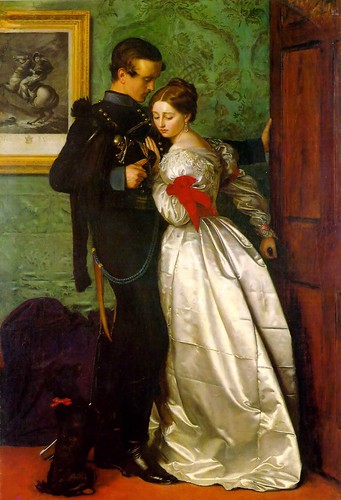John Everett Millais [English Pre-Raphaelite Painter, 1829-1896]
From the Flickr page:
"Historical Background from the Lady Lever Art Gallery:
The theme of "The Black Brunswicker" is an imaginative incident highlighting a historical moment. The Black Brunswickers were a special troop raised by Frederick William Duke of Brunswick (1771-1815) in 1809. The regiment consisted of the best German gentlemen and was known as the "Death or Glory," a name which was derived from their distinctive death’s head hat badge and their apparent devotion to duty. The troops suffered severe losses at the battle of Quatre Bras at Waterloo in 1815. In a letter to Effy, Millais described his idea and his enthusiasm for the subject:
"My subject appears to me, too, most fortunate, and Russell (the war correspondent of Times) thinks it first-rate… I have it all in my mind’s eye and feel confident that it will be a prodigious success. The costume and incident are so powerful that I am astonished it has never been touched upon before. Russell was quite struck with it, and he is the best man for knowing the public taste. Nothing could be kinder than his interest, and he is to set about getting all the information that is required."
Millais spent three months painting "The Black Brunswicker." Studies for the work exist both in the Lady Lever Art Gallery’s archives as well as in Tate Britain.
Millais used Charles Dickens’s daughter Kate as the model for the girl and a private in the Life Guards for the soldier. Each had to model separately for this passionate scene because of the strict Victorian morals of the time.
Millais wished to be historically accurate in making the girl’s dress look quite antique. (It is actually a compromise between the fashions of 1859 and 1815 when waists were still kept high). The intensity of emotions is well conveyed in the close encounter of the couple, the girl’s body attempting to obstruct the soldier from his task and prevent his destiny.
The dark and enclosed space enhances the tragedy of the scene. The work appeals both to spectators’ patriotism and sentimentality. The only distraction is perhaps the brilliant shine of the girl’s dress, its creases tempting spectators’ tactile senses. The dog at the soldier’s feet also draws attention to the humanity of the subject.
On the wall of the room an engraving of a painting by JL David (1748-1825), depicting Napoleon crossing the Alps serves as a reminder of Waterloo while also alluding to current events in 1860, when Napoleon III entered upon a war in Northern Italy in an attempt to expel the Austrians. "





2 comments:
If you or your readers would like to learn more about the Lady Lever Art Gallery and its collections, then please visit our website:National Museums Liverpool
Hi, thanks for the link.
Post a Comment